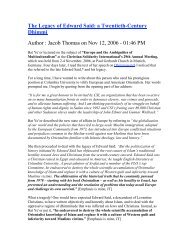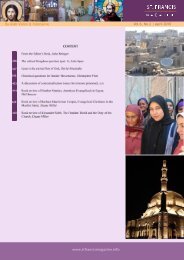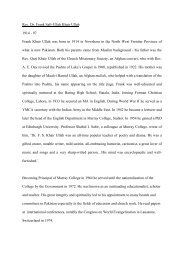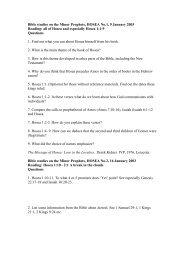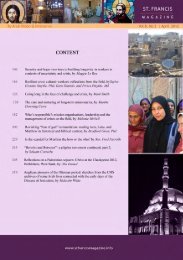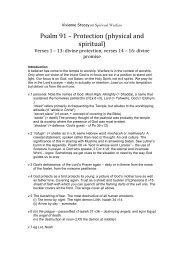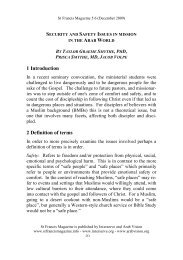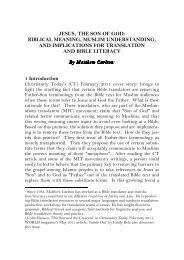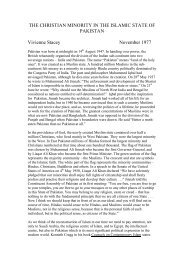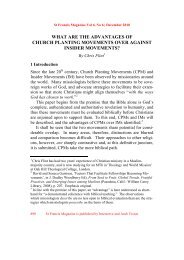download the pdf - St.Francis Magazine
download the pdf - St.Francis Magazine
download the pdf - St.Francis Magazine
You also want an ePaper? Increase the reach of your titles
YUMPU automatically turns print PDFs into web optimized ePapers that Google loves.
<strong>St</strong> <strong>Francis</strong> <strong>Magazine</strong> Vol 8, No 4 | August 2012<br />
<strong>the</strong>ir religion by defining <strong>the</strong> “o<strong>the</strong>r” with isolation, humiliation and<br />
even death. <strong>St</strong>igmatized groups are Jews, Christians, and Sabaeans,<br />
who ultimately have been defined as infidels (kafir) to be subjugated<br />
through <strong>the</strong> poll tax (jizyah) or to be killed.<br />
9.4 Fear and Distrust<br />
Among Iranians a culture of fear and distrust is endemic. Bar-Tal<br />
identifies two types of fear reaction: results of cues, which directly<br />
imply threat and danger, and conditional stimuli that are nonthreatening<br />
in <strong>the</strong>ir nature (Bal-Tal 2001, 603). Fear is stored in<br />
memory and dominates and controls thinking and prolonged experience<br />
of fear causes overestimation of dangers and threats. His research<br />
reveals a tendency “to cause adherence to known situations<br />
and avoidance of risk, uncertainty, and novel situations; it tends to<br />
cause cognitive freezing, which prevents openness to new ideas.”<br />
(ibid, 604) He also suggests that societies may develop collective<br />
emotional orientations. Intractable conflict tends to dominate <strong>the</strong><br />
collective fear orientation, and thus becomes embedded into <strong>the</strong> collective<br />
memory over time. Fear often becomes contagious.<br />
Oversensitized by fear, a society tends to misinterpret cues and information<br />
as signs of threat and danger, searching for <strong>the</strong> smallest indication<br />
in this direction, even in situations that signal good intentions.<br />
The fear also leads to great mistrust and delegitimization of <strong>the</strong> adversary<br />
because of its harmful acts and threats. (ibid, 609)<br />
The culture of fear and distrust appears to be an underlying reason<br />
for <strong>the</strong> disharmony and conflict so prevalent in Iranian fellowships.<br />
Cultural anthropologist Patai states that discord in <strong>the</strong> Arab<br />
world has always been present since pre-Islamic days. At <strong>the</strong><br />
slightest provocation, violent verbal abuse and threats erupt, which<br />
easily degenerate into physical violence.<br />
The situation is complicated by <strong>the</strong> fact that “unity” is merely a very<br />
abstract and remote ideal, while strife has its historical antecedent and<br />
underpinning in <strong>the</strong> age-old Arab virtues of manliness, aggressiveness,<br />
bravery, heroism, courage, and vengefulness, which have been extolled<br />
by poets for more than thirteen centuries and survive in <strong>the</strong> Arab’s con-<br />
<strong>St</strong> <strong>Francis</strong> <strong>Magazine</strong> is a publication of Interserve and Arab Vision 424




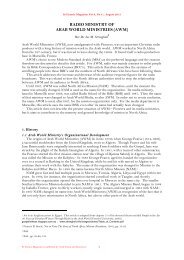
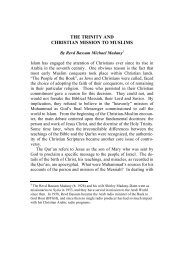
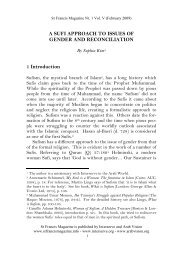
![Reflections on Surah Fatiha and the Lord's Prayer[1] - St.Francis ...](https://img.yumpu.com/49377951/1/184x260/reflections-on-surah-fatiha-and-the-lords-prayer1-stfrancis-.jpg?quality=85)
